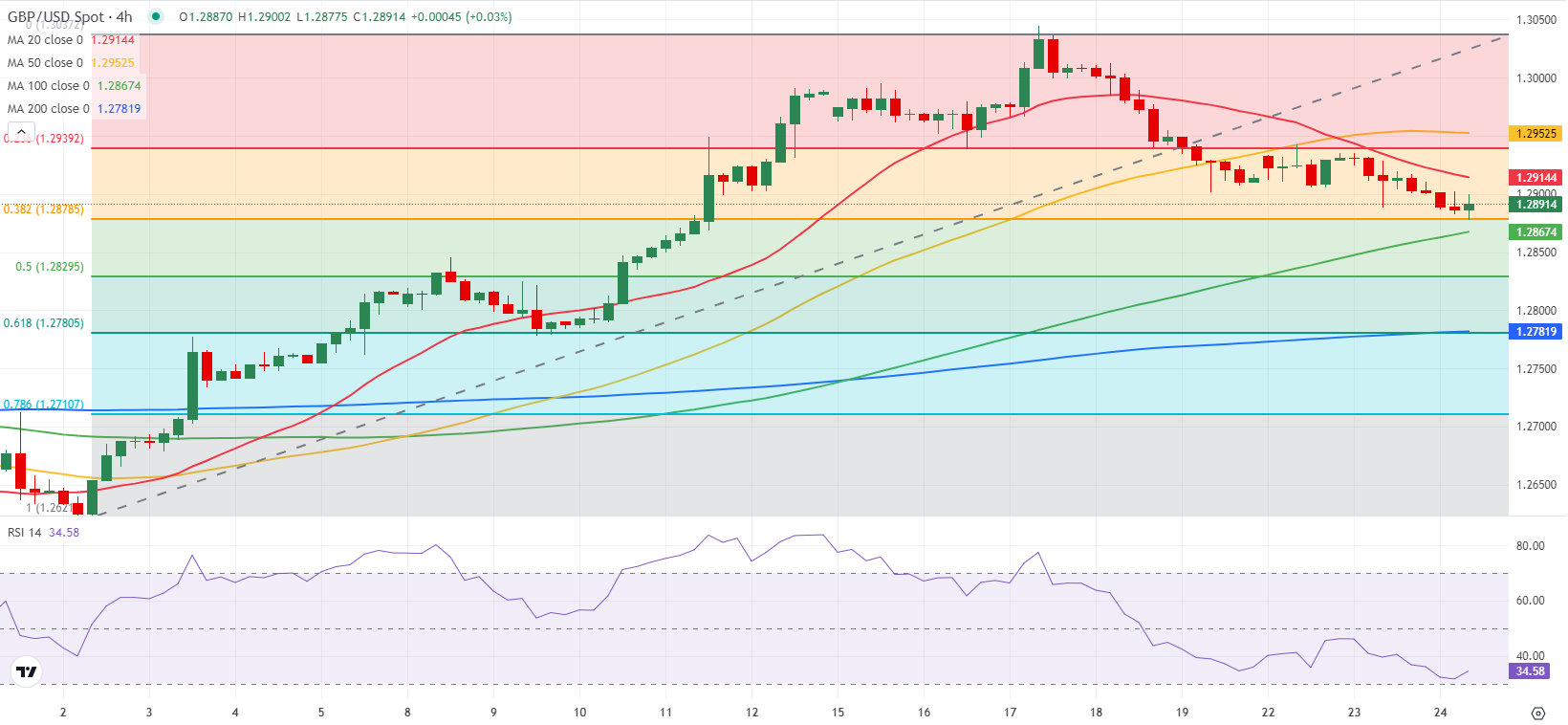- GBP/USD stays on the back foot despite upbeat UK PMI data.
- The risk-averse market atmosphere helps the US Dollar hold its ground.
- Investors await S&P Global PMI data from the US.
After closing in negative territory on Tuesday, GBP/USD continued to edge lower and touched its lowest level since July 11 below 1.2880. Although the pair managed to edge higher in the European session, it seems to be having a difficult time gathering recovery momentum.
British Pound PRICE This week
The table below shows the percentage change of British Pound (GBP) against listed major currencies this week. British Pound was the weakest against the Japanese Yen.
| USD | EUR | GBP | JPY | CAD | AUD | NZD | CHF | |
|---|---|---|---|---|---|---|---|---|
| USD | 0.44% | 0.16% | -1.66% | 0.56% | 1.38% | 1.44% | 0.09% | |
| EUR | -0.44% | -0.29% | -2.11% | 0.08% | 0.98% | 0.94% | -0.42% | |
| GBP | -0.16% | 0.29% | -1.95% | 0.36% | 1.27% | 1.22% | -0.15% | |
| JPY | 1.66% | 2.11% | 1.95% | 2.28% | 3.15% | 3.10% | 1.70% | |
| CAD | -0.56% | -0.08% | -0.36% | -2.28% | 0.90% | 0.87% | -0.49% | |
| AUD | -1.38% | -0.98% | -1.27% | -3.15% | -0.90% | -0.04% | -1.40% | |
| NZD | -1.44% | -0.94% | -1.22% | -3.10% | -0.87% | 0.04% | -1.31% | |
| CHF | -0.09% | 0.42% | 0.15% | -1.70% | 0.49% | 1.40% | 1.31% |
The heat map shows percentage changes of major currencies against each other. The base currency is picked from the left column, while the quote currency is picked from the top row. For example, if you pick the British Pound from the left column and move along the horizontal line to the US Dollar, the percentage change displayed in the box will represent GBP (base)/USD (quote).
The data from the UK showed that the S&P Global/CIPS Composite PMI improved to 52.7 in July's flash estimate from 52.3 in June, highlighting an ongoing expansion in the private sector's business activity at an accelerating pace.
Assessing the survey's findings, "policymakers will likely take a cautious approach to loosening policy amid signs of inflationary pressures pivoting away from services towards manufacturing, where Red Sea shipping delays and higher freight prices are adding to costs again," said Chris Williamson Chief Business Economist at S&P Global Market Intelligence. "The renewed hiring trend could also add to pay pressures, sustaining some stickiness of inflation in the coming months.”
Despite the upbeat UK PMI data, the risk-averse market atmosphere doesn't allow GBP/USD to regain its traction. At the time of press, UK's FTSE 100 Index was down nearly 0.5% on the day and US stock index futures were losing between 0.5% and 0.9%.
Later in the day, S&P Global will release July PMI data for the US. Unless either of the Manufacturing or the Services PMI unexpectedly falls below 50, the US Dollar could preserve its strength and continue to cap the pair's upside, given the negative shift seen in risk mood.
GBP/USD Technical Analysis
The Relative Strength Index (RSI) indicator on the 4-hour chart declines toward 30, reflecting a buildup of bearish momentum. On the downside, 1.2875-1.2870 (100-period Simple Moving Average (SMA), Fibonacci 38.2% retracement of the latest uptrend) aligns as immediate support before 1.2830 (Fibonacci 50% retracement) and 1.2800 (psychological level, static level).
1.2900 (psychological level, static level) could be seen as first resistance before 1.2940-1.2950 (Fibonacci 23.6% retracement, 50-period SMA).
Pound Sterling FAQs
The Pound Sterling (GBP) is the oldest currency in the world (886 AD) and the official currency of the United Kingdom. It is the fourth most traded unit for foreign exchange (FX) in the world, accounting for 12% of all transactions, averaging $630 billion a day, according to 2022 data. Its key trading pairs are GBP/USD, aka ‘Cable’, which accounts for 11% of FX, GBP/JPY, or the ‘Dragon’ as it is known by traders (3%), and EUR/GBP (2%). The Pound Sterling is issued by the Bank of England (BoE).
The single most important factor influencing the value of the Pound Sterling is monetary policy decided by the Bank of England. The BoE bases its decisions on whether it has achieved its primary goal of “price stability” – a steady inflation rate of around 2%. Its primary tool for achieving this is the adjustment of interest rates. When inflation is too high, the BoE will try to rein it in by raising interest rates, making it more expensive for people and businesses to access credit. This is generally positive for GBP, as higher interest rates make the UK a more attractive place for global investors to park their money. When inflation falls too low it is a sign economic growth is slowing. In this scenario, the BoE will consider lowering interest rates to cheapen credit so businesses will borrow more to invest in growth-generating projects.
Data releases gauge the health of the economy and can impact the value of the Pound Sterling. Indicators such as GDP, Manufacturing and Services PMIs, and employment can all influence the direction of the GBP. A strong economy is good for Sterling. Not only does it attract more foreign investment but it may encourage the BoE to put up interest rates, which will directly strengthen GBP. Otherwise, if economic data is weak, the Pound Sterling is likely to fall.
Another significant data release for the Pound Sterling is the Trade Balance. This indicator measures the difference between what a country earns from its exports and what it spends on imports over a given period. If a country produces highly sought-after exports, its currency will benefit purely from the extra demand created from foreign buyers seeking to purchase these goods. Therefore, a positive net Trade Balance strengthens a currency and vice versa for a negative balance.
Information on these pages contains forward-looking statements that involve risks and uncertainties. Markets and instruments profiled on this page are for informational purposes only and should not in any way come across as a recommendation to buy or sell in these assets. You should do your own thorough research before making any investment decisions. FXStreet does not in any way guarantee that this information is free from mistakes, errors, or material misstatements. It also does not guarantee that this information is of a timely nature. Investing in Open Markets involves a great deal of risk, including the loss of all or a portion of your investment, as well as emotional distress. All risks, losses and costs associated with investing, including total loss of principal, are your responsibility. The views and opinions expressed in this article are those of the authors and do not necessarily reflect the official policy or position of FXStreet nor its advertisers. The author will not be held responsible for information that is found at the end of links posted on this page.
If not otherwise explicitly mentioned in the body of the article, at the time of writing, the author has no position in any stock mentioned in this article and no business relationship with any company mentioned. The author has not received compensation for writing this article, other than from FXStreet.
FXStreet and the author do not provide personalized recommendations. The author makes no representations as to the accuracy, completeness, or suitability of this information. FXStreet and the author will not be liable for any errors, omissions or any losses, injuries or damages arising from this information and its display or use. Errors and omissions excepted.
The author and FXStreet are not registered investment advisors and nothing in this article is intended to be investment advice.
Recommended Content
Editors’ Picks

EUR/USD treads water just above 1.0400 post-US data
Another sign of the good health of the US economy came in response to firm flash US Manufacturing and Services PMIs, which in turn reinforced further the already strong performance of the US Dollar, relegating EUR/USD to the 1.0400 neighbourhood on Friday.

GBP/USD remains depressed near 1.2520 on stronger Dollar
Poor results from the UK docket kept the British pound on the back foot on Thursday, hovering around the low-1.2500s in a context of generalized weakness in the risk-linked galaxy vs. another outstanding day in the Greenback.

Gold keeps the bid bias unchanged near $2,700
Persistent safe haven demand continues to prop up the march north in Gold prices so far on Friday, hitting new two-week tops past the key $2,700 mark per troy ounce despite extra strength in the Greenback and mixed US yields.

Geopolitics back on the radar
Rising tensions between Russia and Ukraine caused renewed unease in the markets this week. Putin signed an amendment to Russian nuclear doctrine, which allows Russia to use nuclear weapons for retaliating against strikes carried out with conventional weapons.

Eurozone PMI sounds the alarm about growth once more
The composite PMI dropped from 50 to 48.1, once more stressing growth concerns for the eurozone. Hard data has actually come in better than expected recently – so ahead of the December meeting, the ECB has to figure out whether this is the PMI crying wolf or whether it should take this signal seriously. We think it’s the latter.

Best Forex Brokers with Low Spreads
VERIFIED Low spreads are crucial for reducing trading costs. Explore top Forex brokers offering competitive spreads and high leverage. Compare options for EUR/USD, GBP/USD, USD/JPY, and Gold.
